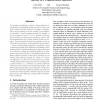Free Online Productivity Tools
i2Speak
i2Symbol
i2OCR
iTex2Img
iWeb2Print
iWeb2Shot
i2Type
iPdf2Split
iPdf2Merge
i2Bopomofo
i2Arabic
i2Style
i2Image
i2PDF
iLatex2Rtf
Sci2ools
122
click to vote
ICCV
2003
IEEE
2003
IEEE
Feature Selection for Unsupervised and Supervised Inference: the Emergence of Sparsity in a Weighted-based Approach
The problem of selecting a subset of relevant features in a potentially overwhelming quantity of data is classic and found in many branches of science. Examples in computer vision, text processing and more recently bio-informatics are abundant. In text classification tasks, for example, it is not uncommon to have 104 to 107 features of the size of the vocabulary containing word frequency counts, with the expectation that only a small fraction of them are relevant. Typical examples include the automatic sorting of URLs into a web directory and the detection of spam email. In this work we present a definition of "relevancy" based on spectral properties of the Laplacian of the features' measurement matrix. The feature selection process is then based on a continuous ranking of the features defined by a leastsquares optimization process. A remarkable property of the feature relevance function is that sparse solutions for the ranking values naturally emerge as a result of a &...
Computer Vision | Feature Relevance Function | Feature Selection Algorithm | Feature Selection Process | ICCV 2003 | Least-squares Optimization Process | Leastsquares Optimization Process |
| Added | 15 Oct 2009 |
| Updated | 15 Oct 2009 |
| Type | Conference |
| Year | 2003 |
| Where | ICCV |
| Authors | Lior Wolf, Amnon Shashua |
Comments (0)

